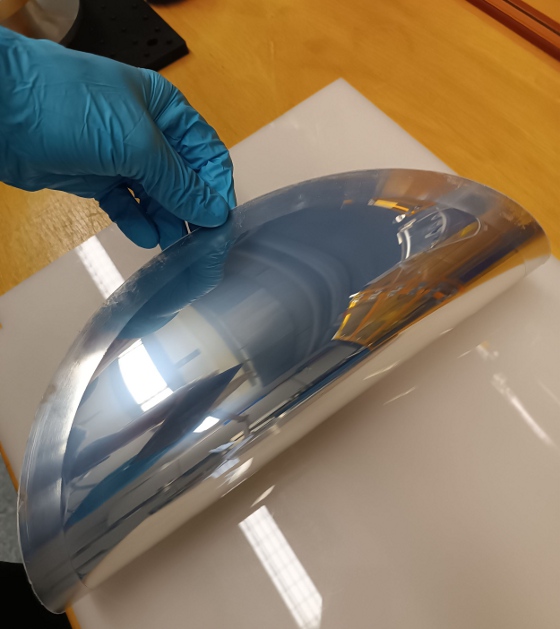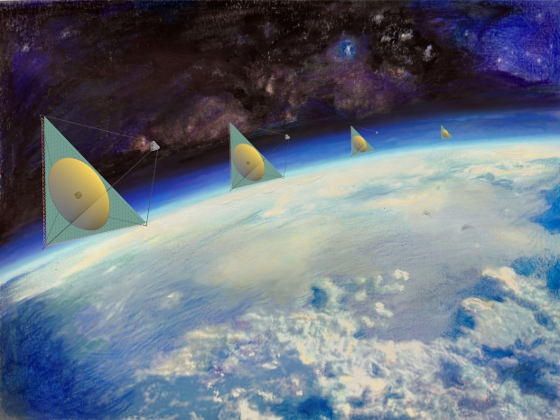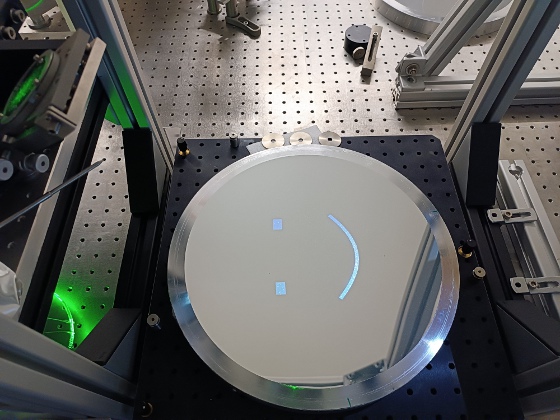 |
| April 11, 2023 | Volume 19 Issue 14 |
Designfax weekly eMagazine
Archives
Partners
Manufacturing Center
Product Spotlight
Modern Applications News
Metalworking Ideas For
Today's Job Shops
Tooling and Production
Strategies for large
metalworking plants
New membrane mirrors can be rolled up for large telescopes in space
Researchers have developed a new way to produce and shape large, high-quality mirrors that are much thinner than the primary mirrors previously used for telescopes deployed in space. The resulting mirrors are flexible enough to be rolled up and stored compactly inside a launch vehicle.
"Launching and deploying space telescopes is a complicated and costly procedure," said Sebastian Rabien from the Max Planck Institute for Extraterrestrial Physics in Germany. "This new approach, which is very different from typical mirror production and polishing procedures, could help solve weight and packaging issues for telescope mirrors, enabling much larger, and thus more sensitive, telescopes to be placed in orbit."

Membrane mirrors made using a new technique are flexible enough to be rolled up. This could be helpful for storing the mirrors inside a launch vehicle. [Credit: Sebastian Rabien, Max Planck Institute for Extraterrestrial Physics]
In the Optica Publishing Group journal Applied Optics, Rabien reports successful fabrication of parabolic membrane mirror prototypes up to 30 cm in diameter. These mirrors, which could be scaled up to the sizes needed in space telescopes, were created using chemical vapor deposition to grow membrane reflective surfaces on a rotating liquid inside a vacuum chamber. He also developed a method that uses heat to adaptively correct imperfections that might occur after the mirror is unfolded.
"Although this work only demonstrated the feasibility of the methods, it lays the groundwork for larger, packable mirror systems that are less expensive," said Rabien. "It could make lightweight mirrors that are 15 or 20 meters in diameter a reality, enabling space-based telescopes that are orders of magnitude more sensitive than ones currently deployed or being planned."
Applying an old process in a new way
The new method was developed during the COVID-19 pandemic, which Rabien says gave him some extra time to think and try out new concepts. "In a long series of tests, we researched many liquids to find out their usability for the process, investigated how the polymer growth can be carried out homogeneously, and worked to optimize the process," he said.
For chemical vapor deposition, a precursor material is evaporated and thermally split into monomeric molecules. Those molecules deposit on the surfaces in a vacuum chamber and then combine to form a polymer. This process is commonly used to apply coatings such as the ones that make electronics water resistant, but this is the first time it has been used to create parabolic membrane mirrors with the optical qualities necessary for use in telescopes.

The new method to make telescope mirrors could enable much larger, and thus more sensitive, telescopes to be placed in orbit. [Credit: Sebastian Rabien, Max Planck Institute for Extraterrestrial Physics]
To create the precise shape necessary for a telescope mirror, the researchers added a rotating container filled with a small amount of liquid to the inside of the vacuum chamber. The liquid forms a perfect parabolic shape onto which the polymer can grow, forming the mirror base. When the polymer is thick enough, a reflective metal layer is applied to the top via evaporation, and the liquid is washed away.
"It has long been known that rotating liquids that are aligned with the local gravitational axis will naturally form a paraboloid surface shape," said Rabien. "Utilizing this basic physics phenomenon, we deposited a polymer onto this perfect optical surface, which formed a parabolic thin membrane that can be used as the primary mirror of a telescope once coated with a reflecting surface such as aluminum."
Although other groups have created thin membranes for similar purposes, these mirrors are typically shaped using a high-quality optical mold. Using a liquid to form the shape is much more affordable and can be more easily scaled up to large sizes.
Reshaping a folded mirror
The thin and lightweight mirror created using this technique can easily be folded or rolled up during the trip to space. However, it would be nearly impossible to get it back to the perfect parabolic shape after unpacking. To reshape the membrane mirror, the researchers developed a thermal method that uses a localized temperature change created with light to enable adaptive shape control that can bring the thin membrane into the desired optical shape.
The researchers tested their approach by creating 30-cm diameter membrane mirrors in a vacuum deposition chamber. After much trial and error, they were able to produce high-quality mirrors with a surface shape suitable for telescopes. They also showed that their thermal radiative adaptive shaping method worked well, as demonstrated with an array of radiators and illumination from a digital light projector.

The reflective surfaces are created using chemical vapor deposition to grow membrane mirrors on a rotating liquid inside a vacuum chamber. This allows for a parabolic thin membrane to form that can be used as the primary mirror of a telescope once coated with a reflecting surface such as aluminum. [Credit: Sebastian Rabien, Max Planck Institute for Extraterrestrial Physics]
The new membrane-based mirrors could also be used in adaptive optics systems. Adaptive optics can improve the performance of optical systems by using a deformable mirror to compensate for distortion in incoming light. Because the surface of the new membrane mirrors is deformable, these mirrors could be shaped with electrostatic actuators to create deformable mirrors that are less expensive to make than those created with conventional methods.
Next, the researchers plan to apply more sophisticated adaptive control to study how well the final surface can be shaped and how much of an initial distortion can be tolerated. They also plan to create a meter-sized deposition chamber to better study the surface structure and packaging and unfolding processes for a large-scale primary mirror.
Read "Adaptive Parabolic Membrane Mirrors for Large Deployable Space Telescopes" in Applied Optics.
Source: Applied Optics
Published April 2023
Rate this article
View our terms of use and privacy policy
